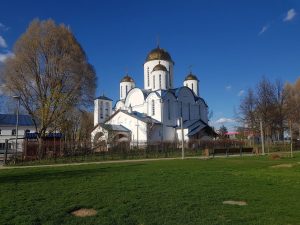Church of the Triumph of Orthodoxy in Altufyevo

The Church of the Triumph of Orthodoxy in Altufyevo is located at the address territory 77, building 2, Altufyevskoe highway. The celebration of the Triumph of Orthodoxy was established in Greece in the IX century, in memory of the final victory over the enemies of Orthodoxy – iconoclasts. The doctrine of the veneration of icons, based on Holy Scripture and approved by the custom of the first Christians, remained inviolable until the eighth century. But the iconoclastic heresy that originated in Greece itself spread to many countries. The Church of God was persecuted more than by the pagans. For more than 100 years, the tears and innocent blood of the true Orthodox had been flowing, who fought for the right to depict Our Lord Jesus Christ, the Mother of God and saints on icons, as well as to pray to them in front of icons. These Orthodox were imprisoned, tortured and executed. Honest icons and relics of saints were burnt. After the Seventh Ecumenical Council (787), which consolidated the veneration of icons, there came a weakening of persecution. In 843, Orthodoxy was solemnly restored at a service in St. Sophia Cathedral in Constantinople on the first Sunday of Lent. In the XII and XIV centuries, the service performed on this day was significantly supplemented by the inclusion of texts depicting the main tenets of Christianity. This service represents the triumph of the Church over all heresies and schisms that have ever existed. It affirms not only the Orthodox teaching on icon worship, but also all the dogmas and resolutions of the seven Ecumenical Councils. Not only icon-worshippers are blessed, but also all those who live and have gone to the Lord in the faith and piety of the fathers. A special place in this service is occupied by the rank of anathematization. Anathema (translated from Greek – “let him be excommunicated”) is proclaimed conciliatorily not only to iconoclasts, but to all who have committed grave sins before the Church. In Russia, the rank of Orthodoxy was introduced in the XIV century. It was performed in cathedrals after the reading of the hours or before the end of the Liturgy in the middle of the temple in front of the icons of the Savior and the Mother of God reclining on the lectern. The rite contains the reading of the Symbol of Faith, the utterance of anathema and the proclamation of Eternal memory to all defenders of Orthodoxy. Anathema is not a curse, it is not an act that irrevocably closes the way to return to the Church and salvation. With repentance and sufficient grounds, the anathema can be lifted. It may be removed after death.
Address: Moscow, Altufyevskoe sh., 77, building 2

